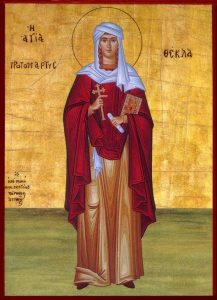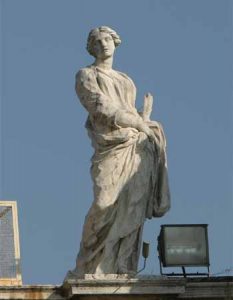Saint Thecla was a contemporary of Saint Paul who became an evangelizer after hearing his teachings.
Thecla was born to a rich family in Iconium, a town in Asia Minor. She was expected to marry and marry well. In fact, her mother had a young man picked out for her. He had an excellent position and could offer Thecla a secure life. This was important in Thecla’s day because an unmarried woman could find herself with no support and no money. Marriage assured a stable place in society, with children to carry on the family name.
But something happened to Thecla that made her turn away forever from her mother’s dream. The apostle Paul, who had been in Antioch, traveled to Iconium and began teaching at a house near Thecla’s. She sat in her open window for three days and nights, listening as Paul spoke about the blessings of giving everything to God. Thecla decided not to marry and to devote her life to Jesus Christ.
Her fiancé Thamyris was furious and complained to the local governor that Paul was a bad influence. Because Thamyris was so prominent, Paul was arrested and imprisoned.
Late at night Thecla secretly went to the prison, bribed the guards, and stayed to hear Paul’s teaching. When her family found her, they turned her and Paul over to the authorities. Paul was driven from the city and Thecla was sentenced to death. Her mother was so angry at her daughter’s disobedient “madness” that she wouldn’t intervene.
Thecla was tortured, but God delivered her from death. She found her way to Antioch and soon met Paul there. She helped him preach, and together they did good work for the Lord.
But once again a powerful person, this time the city governor, tried to turn Thecla toward marriage. When she hurt his pride by refusing he denounced her to the authorities. She was arrested and sentenced to die in the arena. But the wild beasts wouldn’t harm her, and when their attempt to drown her also failed, the officials were so frightened that they let her go. She retreated to a rocky desert cave in the mountains near the town of Ma’aloula, Syria. Through her prayer, she converted many and gathered other women monastics around her. She counseled people and healed the sick, never asking for money.
Even there, though, she was pursued. Jealous pagan doctors sent young men to harm the saint, now an old woman. But God heard her prayers and opened up a fissure in the rock of the cave. Thecla rushed into the space, which immediately closed up again.
Today you can visit Thecla’s cave, and see in it the still-running spring that provided water for her. The nuns who live in the Mar Thecla monastery there will tell you her story and show you the fissure in the rock where this saint, “Equal to the Apostles”, left the world and joined her Lord in the Kingdom. (1)
Thecla was one of the earliest popular figures of the Church who did not personally know Jesus of Nazareth. At some point before or during the Byzantine era, she began to be venerated as a saint. The site of her cave was identified in Syria near the modern-day city of Maloula. A church was built in the mouth of the cave in very early times, and later the site became home to a large monastery, the Mar Taqla. The Mar Taqla Monastery has been around, in one form or another, ever since. The local Christian community, though small, is one of the world’s oldest, and is the only one to speak Aramaic, the language probably spoken by Jesus of Nazareth. This makes a visit to Maloula an even more authentic experience for pilgrims. (2)
1"Saint Thecla" Department of Christian Education Orthodox Church in America http://dce.oca.org/assets/templates/bulletin.cfm?mode=html&id=101 (10/16/2019)
2"Cave of St. Thecla"https://thecompletepilgrim.com/cave-st-thecla/ (10/17/2019)



